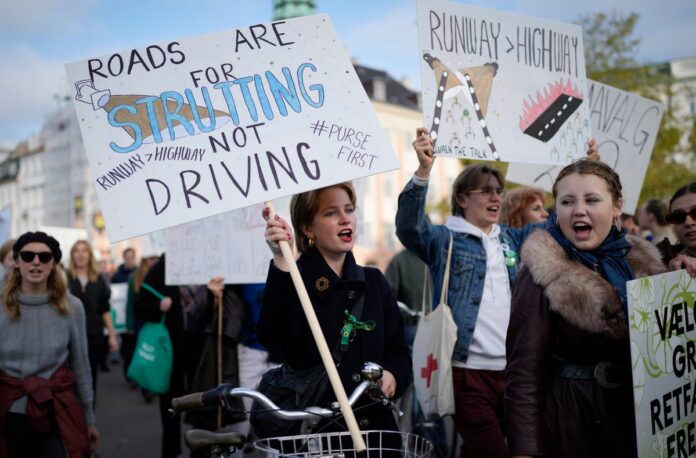Denmark’s election on Tuesday is expected to change its political landscape, with new parties hoping to enter parliament and others seeing their support dwindle. A former prime minister who left his party to create a new one this year could end up as a kingmaker, with his votes being needed to form a new government.Neither the center-left nor the center-right is likely to capture a majority, which is 90 seats in the 179-seat Folketing. That could leave former Prime Minister Lars Løkke Rasmussen in the pivotal role as he seeks to bridge the center. When announcing the election in October – seven months before the end of her four-year term – Prime Minister Mette Frederiksen said she wanted ‘a broad government with parties on both sides of the political middle.’ She stressed that Denmark – like the rest of Europe – is going through tough times and lawmakers need to stand together.The announcement came when an ally of her minority, one-party Social Democratic government threatened to topple Frederiksen with a confidence vote. The center-left Social Liberals were critical of her government’s handling of the 2020 decision to wipe out Denmark’s entire captive mink population at the height of the coronavirus pandemic to protect humans from a mutation of the virus.The culling led to strong controversy and to a minister’s resignation. The needed legislation was put in place more than a month after the cull had started, and a parliament-appointed commission eventually criticized the government, saying Frederiksen had been ‘grossly misleading.’ Frederiksen said she didn’t know the culling decision was unlawful, but the Social Liberal Party maintained its ultimatum: hold a new election or face a confidence vote. More than 4 million voters in the small northern European Union nation can choose among 14 parties on Tuesday. Domestic themes have dominated the campaign, ranging from tax cuts and a need to hire more nurses to financially supporting Danes amid inflation and soaring energy prices because of Russia’s war in Ukraine.The mink issue faded away once campaigning got underway. Also absent from the debate is immigration, once a key political issue in Denmark, which the major political parties now largely agree on, said Kasper Møller Hansen, professor of political science at the University of Copenhagen. In recent decades, Denmark has adopted some of the strictest immigration laws in the EU.At least three politicians are vying to become prime minister. They include Frederiksen, who steered Denmark through the COVID-19 pandemic and teamed up with the opposition to hike Danish defense spending in the wake of Russia’s invasion of Ukraine, and the two center-right opposition lawmakers – Jakob Ellemann-Jensen, the Liberal leader, and Søren Pape Poulsen, who heads the Conservatives.A former Liberal leader, Løkke Rasmussen, lost to Frederiksen in 2019 and created his new centrist party in June. According to the polls, his Moderates could get as much as 10% of the vote. He has hinted he could see a ruling coalition with the Social Democrats and could also be considered a prime minister candidate.The last time Denmark was governed by a centrist coalition was in 1978 when the Social Democrats teamed up with the Liberals. That lasted eight months.The center-right bloc includes populist, anti-immigration parties. Among them are the Denmark Democrats, created in June by former hard-line immigration minister Inger Støjberg. In 2021, Støjberg was convicted by the rarely used Impeachment Court for ordering in 2016 to separate asylum-seeking couples if one of the partners was a minor. She has served her 60 days’ sentence and is now eligible to run again. Pollsters say her party could get around 7% support. That could threaten the once-powerful populist, anti-immigration Danish People’s Party, which has been falling apart in recent months because of internal disputes and is hovering around the 2% threshold needed to enter parliament. In 2015, the party grabbed 21.1% of the vote.The Danish People’s Party, which played a key role when Denmark tightened its immigration laws, has seen leading members leave to join Støjberg’s party or simply quit politics. Her party is similar to another one – the small nationalistic, anti-immigration New Right party – that is already in parliament. They have called for a broad center-right government.The Social Liberals, who gave the ultimatum to Frederiksen, could suffer a loss of support, chiefly because voters don’t trust the party. Its leader, Sofie Carsten Nielsen, has declared that the party will, after all, back Frederiksen for prime minister – a statement she has had trouble explaining. Møller Hansen believes that once the election is over, talks to form a new Danish government will take some time.’I believe we’ll again see a minority government in Denmark, which would seek support from the left in climate issues and from the right when it comes to immigration,’ he said.
Danish election could pave the way for a centrist government
Sourceindependent.co.uk
RELATED ARTICLES


